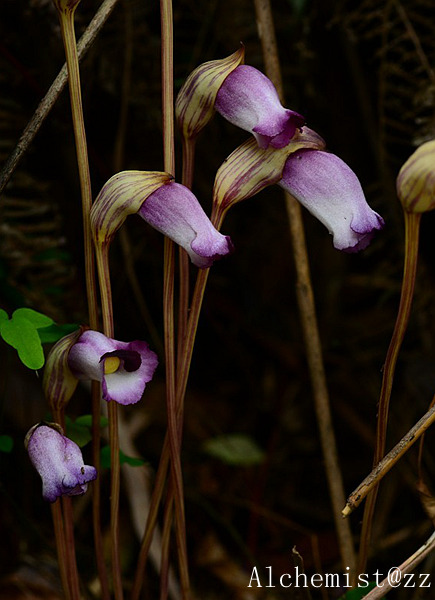
- Scientific Name: Aeginetia indica L.
- Ref: Sp. Pl.:632. 1753
- Synonyms: Aeginetia boninensis Nakai; A. indica var. gracilis Nakai; A. japonica Siebold & Zucc.; A. mairei H.Lév.; Phelypaea indica (L.) Spreng. ex Steud.
- English Common Name: Indian broomrape, forest ghost flower
- Chinese Common Name: 野菰 yěgū
- Japanese Common Name: ナンバンギセル [南蛮煙管] nanbangiseru
- Family: Orobanchaceae
- Genus: Aeginetia
- Distribution: Slopes, roadsides; 200-1800 m. Anhui, Fujian, Guangdong, Guangxi, Guizhou, Hunan, Jiangsu, Jiangxi, Sichuan, Taiwan, Yunnan, Zhejiang [Bangladesh, Bhutan, Cambodia, India, Indonesia, Japan, Laos, Malaysia, Myanmar, Nepal, Philippines, Sri Lanka, Thailand, Vietnam].
- Photo: 10/03/2013, Guilin, Guangxi
Plants 15-40(-50) cm tall. Root slightly fleshy, with small branches. Stems unbranched or branched from near base. Leaves red, ovate-lanceolate or lanceolate, 5-10 X 3-4 mm, glabrous. Flowers usually solitary. Pedicel usually erect, 10-30(-40) cm, ca. 3 mm in diam. Calyx apex acute or acuminate. Corolla purple-red striate, indistinctly bilabiate, tubular-campanulate, 2-4.5 cm; tube slightly curved; lobes subentire. Filaments purple, 7-9 mm, glabrous; anthers yellow. Ovary 1-locular; parietal placentas 4. Style 1-1.5 cm; stigma pale yellow. Capsule conical, or long ovoid-globose, 2-3 cm. Seeds yellow, ellipsoid, ca. 0.04 mm. Fl. Apr-Aug, fr. Aug-Oct. 2n = 30. (Flora of China)
